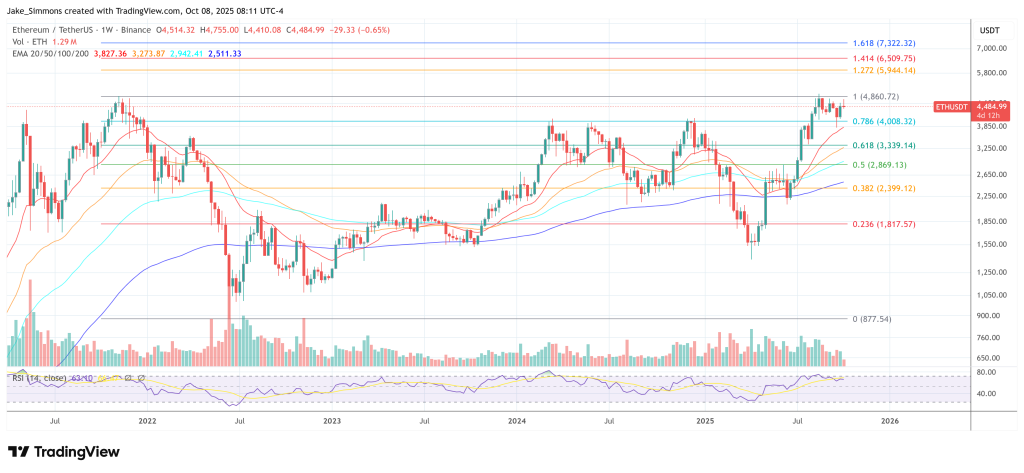Ethereum co-founder and ConsenSys CEO Joseph Rubin appeared on Bloomberg Crypto on October 7 and confirmed that ConsenSys is building a prototype of SWIFT’s new blockchain-based shared ledger. The initiative, announced by SWIFT itself at Sibos in Frankfurt last week, will bolt a permissioned, always-on ledger to the global messaging cooperative’s infrastructure and natively integrate ISO. 20022 Financial Message.
SWIFT is powered by Ethereum
Rubin said the first build “will almost certainly implement messaging using ISO 20022 and financial messaging,” adding that while SWIFT itself is “careful to stay in its lane and focus on the messaging part,” some participating banks are “interested in potentially jumping into the payments layer.”
“I have to be careful what I say. This is a project that we’re building. They have engineers on their side, we have a lot of engineers on our side. And I’m glad they call it a prototype, because that’s what it is,” the ConsenSys founder added.
He did not provide a timeline for implementation. “We have an idea of what the timeline will be, but we can’t say too much. We’ve defined what we believe the end state will be and we’re retracting it, so I don’t know if SWIFT would be comfortable releasing a timeline publicly at this point,” Rubin said.
The SWIFT move is clearly framed as a shared ledger that records, orders and verifies transactions, and was announced on September 29, with the cooperative highlighting that the project aims to accelerate the “transition to digital finance” by providing instant, 24/7 cross-border transactions on a global scale, while remaining asset agnostic and interoperable with public and private networks. Although the official document did not name the base chain, it named ConsenSys as a core technology partner and emphasized its compliance with ISO 20022 and business rules applying smart contracts.
In an interview with Bloomberg, Rubin emphasized a broader strategic shift. The long-standing separation between “TradFi” and “DeFi” is crumbling. “Since the launch of Ethereum, we have had to ride our own rails…The atmosphere in Frankfurt was very different,” he said, explaining the overwhelmingly positive feedback from banks and saying, “It was time for TradFi to merge or go with DeFi.” He also characterized the current build as a true prototype with technologists “on their side and a lot of it on our side,” and reiterated that SWIFT will control the scope of messaging while banks explore deeper layers such as atomic payments.
What “using Ethereum” actually means
Although SWIFT did not formally specify the underlying chain in its press release, multiple industry reports after Sibos and later Rubin’s public statements say the prototype will run on Ethereum infrastructure, specifically ConsenSys’ Linea, an Ethereum layer 2 network that uses zero-knowledge proofs, positioning the build within the Ethereum ecosystem while maintaining permissioned boundaries consistent with bank compliance. requirements. This report is consistent with ConsenSys’ own statement that it is “supporting Swift in early prototyping” of the shared ledger.
The institutional context is important. SWIFT’s ledger efforts come amid rapid growth in the $300 billion stablecoin market and a wave of bank tokenization trials. Its design goal is to extend rather than replace existing rails, allowing banks to opt-in to the tokenized process, increasing speed, transparency, and finality.
Beyond SWIFT: Rubin’s Treasury Papers
Rubin also used a segment on Bloomberg to discuss the rise of “digital asset-backed bonds” (DATs), such as the Ethereum-focused entity he chairs at Sharplink. He argued that corporate accumulation of Ether is a “volatility suppressant,” described Ether as “a productive, high-yield asset, unlike Bitcoin” when staked, and outlined a Berkshire-style flywheel that would deploy a growing ETH base across Ethereum-aligned protocols with the aim of being non-dilutive.
Strategic consistency is clear. As established financial institutions standardize on Ethereum-based rails for messaging and, increasingly, payments, ETH on their balance sheets will become a strategic asset for financial institutions seeking exposure to network activity and yield.
At the time of writing, ETH was trading at $4,484.

Featured image created with DALL.E, chart on TradingView.com
editing process for is focused on providing thoroughly researched, accurate, and unbiased content. We adhere to strict sourcing standards, and each page is carefully reviewed by our team of top technology experts and experienced editors. This process ensures the integrity, relevance, and value of your content to your readers.














